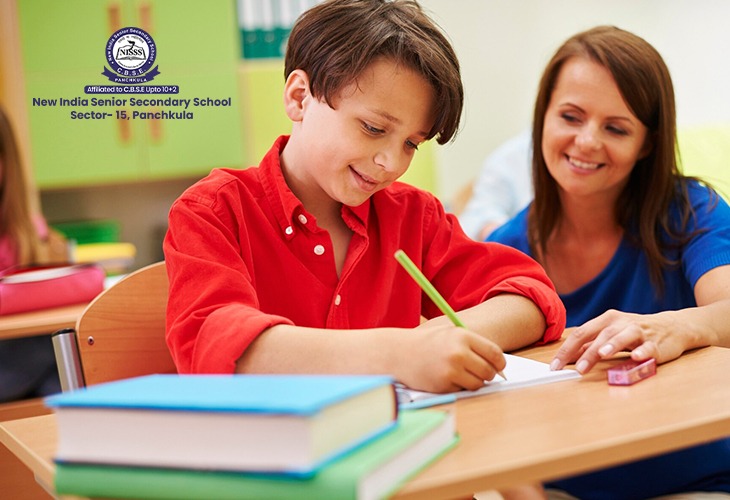Mindfulness in the Classroom: Techniques to Help Students Focus and Relax
It can be challenging for students to concentrate on their studies in the fast-paced world of today because of the many demands, distractions, and stressors they encounter. At New India Senior Sec. School, the Best CBSE Schools in Panchkula, we think it’s important to give our pupils the resources they need to be successful both intellectually and emotionally. We place a lot of emphasis on mindfulness as a useful tool that can help students manage stress, stay present, and concentrate on the task at hand. Let’s examine some methods for assisting students in relaxing and focussing as well as the advantages of mindfulness in the classroom.
Why Mindfulness Matters in Education
Mindfulness is the practice of bringing one’s attention to the present moment without judgment. It’s about being aware of thoughts, feelings, and surroundings, which can lead to better emotional regulation and mental clarity. Integrating mindfulness into the classroom has been shown to improve students’ focus, reduce anxiety, and foster a more positive learning environment. Here’s why mindfulness is so beneficial:
- Improved Focus and Concentration
When students practice mindfulness, they learn to direct their attention to the present moment, reducing distractions. This heightened focus enables them to concentrate better during lessons, leading to improved academic performance. - Enhanced Emotional Regulation
Mindfulness teaches students how to observe their emotions without getting overwhelmed by them. This can be especially helpful during stressful times like exams or presentations. When students can manage their emotions effectively, they are better equipped to handle academic challenges. - Reduced Stress and Anxiety
Academic pressures, social expectations, and personal worries can create stress for students. Mindfulness practices, such as deep breathing or meditation, activate the body’s relaxation response, helping students calm their nerves and reduce feelings of anxiety. - Improved Behavior and Classroom Dynamics
A calm and focused classroom is a more productive learning environment. When students practice mindfulness, they are more likely to exhibit positive behaviour, resolve conflicts peacefully, and show empathy toward their peers.
Mindfulness Techniques for the Classroom
At New India Sr. Sec. School, we incorporate mindfulness into our daily routines to create a supportive and balanced learning atmosphere. Here are some simple yet effective techniques that can help students stay focused and relaxed:
- Mindful Breathing
One of the simplest mindfulness practices is mindful breathing. Students are guided to close their eyes, take deep breaths, and focus on the sensation of the breath moving in and out of their bodies. This technique helps students anchor their attention and calm their minds, especially before exams or after a long day. - Body Scan Meditation
In this practice, students are asked to sit or lie down comfortably and mentally “scan” their bodies from head to toe, noticing any tension or discomfort. This technique encourages relaxation and helps students become more aware of how stress affects their bodies. It’s a great way to unwind after a busy school day. - Mindful Listening
In a world full of distractions, students often struggle with active listening. This technique involves listening to a specific sound—like a bell or a calming nature sound—and focusing solely on it. This practice enhances concentration and helps students sharpen their listening skills, which are essential for effective learning. - Five Senses Exercise
The five senses exercise encourages students to use all their senses to become fully present. They are asked to name five things they can see, four things they can touch, three things they can hear, two things they can smell, and one thing they can taste. This technique brings students into the present moment, helping them shift their focus from anxious thoughts to their immediate environment. - Gratitude Journaling
Encouraging students to keep a gratitude journal is another way to practice mindfulness. At the end of each day, students write down three things they are grateful for. This practice promotes a positive mindset, reduces stress, and helps students focus on the good in their lives rather than their worries.
How New India Sr. Sec. School Integrates Mindfulness
At New India Sr. Sec. School, we have created a nurturing environment where mindfulness is embedded into our daily routines. We believe in the long-term benefits of these practices, and our educators are trained to incorporate mindfulness techniques in ways that resonate with students. Here are some ways we bring mindfulness into the classroom:
- Morning Mindfulness Sessions: Each day begins with a short mindfulness exercise, helping students centre themselves before the start of lessons.
- Mid-Day Mindfulness Breaks: Throughout the day, we offer brief breaks where students can practice mindfulness exercises like deep breathing or stretching to reset and refocus.
- Mindful Reflection in the Curriculum: We integrate mindful reflection into subjects like literature, where students reflect on characters’ emotions, and in science, where they observe natural phenomena with full attention.
Conclusion
Our mission at New India Senior Sec. School, one of the Top CBSE School in Panchkula, is to support each student’s academic, emotional, and mental development. Our goal in incorporating mindfulness into the classroom is to give our students the skills they need to concentrate, handle stress, and develop a positive attitude towards learning.
